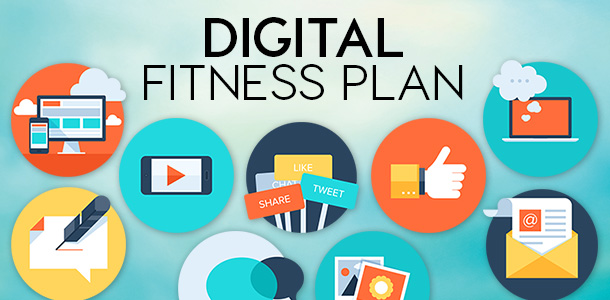BY BRIANNA LIESTMAN & NICHOLAS UPTON
Much like beginning a new workout plan, digital marketing can be very intimidating, so much so that some businesses never bother to start even though they know they should. After all, digital is where the customers are now and they search businesses online way before they ever set foot into a dealership.
However, by starting one step at a time and building a digital profile, companies can create long-term marketing plans that yield significant results.
Before getting started, ask yourself what digital channels you want to be on and why. Are you looking to target a new, younger audience? You may want to be on Instagram. Do you want to connect with your existing customer base? Facebook and email marketing is where you should be.
We’ve created step-by-step lists for specific aspects of your digital strategy. When you’ve mastered one list, move on to the next one and you’ll be on your way to becoming a digital marketing machine.
Video Marketing |
Google Reviews |
Facebook Content |
Thriving PPC |
Email Marketing |
Company Blog |
Slim Your Site |
6 METHODS FOR OPTIMIZING VIDEO MARKETING
![]() People watch 6 billion hours of video on YouTube monthly and more than half of all online traffic is now video. According to Dominion Marine Media’s statistics, pairing a video with a listing shortens the time to sale by an average of 17 percent.
People watch 6 billion hours of video on YouTube monthly and more than half of all online traffic is now video. According to Dominion Marine Media’s statistics, pairing a video with a listing shortens the time to sale by an average of 17 percent.
Here are some important methods for using video to its best advantage for your digital marketing strategy.
1. Get familiar with YouTube
 YouTube is the world’s second-largest search engine, so knowing how to use it is the most important tool a dealer needs to create videos that will influence customers.
YouTube is the world’s second-largest search engine, so knowing how to use it is the most important tool a dealer needs to create videos that will influence customers.
“People buy equipment, they buy software, they try to do all this editing, and it is just so easy and effective to do it these days with your cell phone and YouTube. It’s literally all you need,” said Lenny Rudow, senior editor at boats.com.
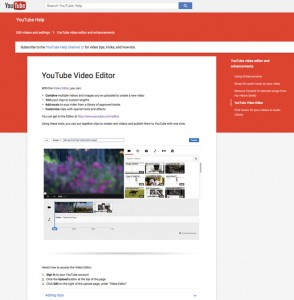 YouTube provides tutorials and “how-to” videos on its editing system: how to shoot, how to embed, how to upload and more, which can be found by searching on the website. Rudow suggests spending a few hours playing with the website before doing anything else with video marketing.
YouTube provides tutorials and “how-to” videos on its editing system: how to shoot, how to embed, how to upload and more, which can be found by searching on the website. Rudow suggests spending a few hours playing with the website before doing anything else with video marketing.
2. Move, move, move
Rudow said dealerships sometimes get into the trap of standing and shooting the boat, which doesn’t show the overall picture of the vessel. Show motion as much as possible. For example, if you show the engine compartment, start with the hatch closed, swing it open and show the engine.
“Not only does this make the video just more pleasant to watch… [but] as you open and close things, move things and change things, it not only lets the viewer remain engaged because things are happening as opposed to static shots, it also educates the viewer more about what the boat has,” said Rudow.
3. Visually and audibly pleasing videos are the most valuable
If you are shooting a walkthrough, clean the boat first. Any scratches or dirt might not seem like they will show, but they do.
“Clean that boat until it sparkles like a gem first. You have to be visually appealing,” said Rudow.
Similarly, dealers should avoid shooting videos near a busy road or on a windy day, because the feedback in the audio is strong and will discourage viewers. Rudow says the only piece of equipment a dealer may want to invest in is a clip-on lapel microphone that plugs into a smartphone, as they are highly effective in curbing sound issues.
4. Don’t fear the reshoot
If you mess up in a clip, start again. Once you know how to use YouTube’s video editor, taking 10 to 30 second clips and creating a useful minute-long video that is clear and professional is easy, said Rudow.
“[Dealers] try to do it all in one breath and it just doesn’t work,” he said. “It’s a lot easier than you think it’s going to be. You do this three or four times and you’ll be like a pro.”
5. Keep it short
Carl Blackwell, president of Grow Boating and Discover Boating, said any video over three minutes runs the risk of losing the viewer’s attention. He suggested dealers consider working with companies that can measure video engagement and point to where viewers drop off the video to help better determine exactly how long the videos should be.
“Consumers, by nature, only have a certain attention span and I think that the quicker you can tell [a story], the better off you are,” said Blackwell.
6. Use real boaters
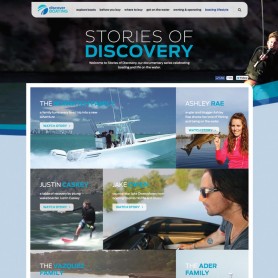 Blackwell said that while Discover Boating’s “Stories of Discovery” videos that featured celebrities like Jake Owen performed well, the stories of real families tended to outperform.
Blackwell said that while Discover Boating’s “Stories of Discovery” videos that featured celebrities like Jake Owen performed well, the stories of real families tended to outperform.
“If you think about word-of-mouth and how popular sites like Yelp are that provide reviews, that’s consumers talking to consumers versus brands talking to consumers,” said Blackwell.
Dealers would benefit from shooting brief testimonial videos from happy customers who can say why they bought their boat from that dealership and answer consumers’ questions.
Manufacturers should focus on lifestyle videos, that appeal to customers’ emotions.
“We think it’s super important, when we come out with a new boat, that we want people to see themselves on the boat,” said Jason Boertjie, director of marketing at MasterCraft Boat Company. “You always want to make sure that there is that type of video.”
4 STEPS TO UTILIZING GOOGLE REVIEWS
![]() Matt Sellhorst, founder of Boat Dealer Profits, used Google reviews as a free marketing tool when he was a pleasure boat specialist at Hall Marine Group. He said Google reviews caused customers to visit the dealership based on the praise his salesmanship received online, versus other dealers in the area that had no reviews.
Matt Sellhorst, founder of Boat Dealer Profits, used Google reviews as a free marketing tool when he was a pleasure boat specialist at Hall Marine Group. He said Google reviews caused customers to visit the dealership based on the praise his salesmanship received online, versus other dealers in the area that had no reviews.
Here are some steps to garner positive reviews that can work as a marketing tool for your dealership.
Step one: Ask your happy customers
Sellhorst focused on asking his 100 happiest clients instead of sending an e-blast to his entire client base. If you send a request to everyone, the first three responses online will be from your three unhappiest customers.
When you reach out to these customers, ask about their boat and follow up with “Would you please do me a favor?”
“If you do a great job, your customers love doing favors for you. That’s just the nature of the human personality,” he says.
Step two: Make it easy to leave a detailed review
When you call and ask for a review, follow it up with an email to show them the quick steps to leaving a review online.
To receive detailed, influential reviews, show your customers an example of a well-written review in the email or ask the customers to answer four questions: Why did you buy from us vs. other dealers? Why did you buy your boat vs. other manufacturers? What surprised you about your experience? Why do you love boating?
“I could guide them to not only do a review but to write one that was going to be really powerful and get into a lot of specific detail, because the more similar the story is to what the person reading it is going through, the more impactful it is,” said Sellhorst.
Step three: Don’t pay for or offer incentives for reviews
 If Google finds out you are incentivizing, they will shut down your reviews and you will not get them back. This means no discounts, coupons, cash, gifts, anything.
If Google finds out you are incentivizing, they will shut down your reviews and you will not get them back. This means no discounts, coupons, cash, gifts, anything.
Step four: Respond to negative reviews
If you have any recent negative reviews, take the issue offline and do everything you can to assist them. Don’t engage in negativity or you will end up looking even worse to a potential customer. Use a message such as “Hey [customer], I apologize you had a bad experience with us. I’m the owner of [dealership], here’s my private line. Please give me a call and let’s see if we can get this resolved for you.”
Sellhorst says that most of the time, some kind of resolution can be found. Once you do, don’t ask customers to delete reviews but do ask them to comment back on the review about how you resolved their issue and if they are satisfied.
Read more about Google reviews in the 2015 Best Ideas white paper at BoatingIndustry.com/e-white-papers.
6 STRATEGIES FOR IMPROVING YOUR FACEBOOK CONTENT
![]() Most companies know they should be on Facebook. The question now becomes “What do I do once I am there? How do I know this is working and worth my time?”
Most companies know they should be on Facebook. The question now becomes “What do I do once I am there? How do I know this is working and worth my time?”
Below are some strategies for posting to Facebook and how to ensure it is yielding the results you desire.
1. Save the selling for the sales floor
Facebook is a great way to connect with customers. Pushing sales information to customers is not the way to reach them. Companies can use Facebook as a tool for highlighting their unique brand voice.
“Yes, consumers are looking for that and they expect that when you’re engaging with them, but at the same time, if I’m meeting with you for coffee once a month or week and all I talk about is ‘Hey, did you know we’ve got this sale going on? Hey, did you know we have this new product?’ You’re going to stop hanging out with me pretty quickly because it gets boring,” said Samantha Scott, APR, president of Pushing the Envelope, Inc. “Businesses forget that that’s exactly what’s happening when they’re using their social media channels as advertising channels. It’s supposed to be communication.”
2. Diversify your content
Scott says it’s important to post a mixture of photos, videos, links, text and shares in order to work with Facebook’s new algorithms.
“It’s kind of that five-part mix because Facebook wants to see you producing genuine content and a mixture of different types,” said Scott.
3. Measure your engagement
 If you’re going to spend time, money or both on something, you should know whether or not it’s working. It doesn’t matter if you have 10,000 Facebook likes if no one is engaging with the content you post.
If you’re going to spend time, money or both on something, you should know whether or not it’s working. It doesn’t matter if you have 10,000 Facebook likes if no one is engaging with the content you post.
“That’s why you’re doing it, because you want someone to engage in the content, to further your message by sharing it or otherwise engaging in it, and also for them to take action, for them to go to your site, make a phone call and do something,” said Scott.
4. Benchmark your performance
This includes benchmarking within and outside of the industry.
“There are going to be some things that aren’t applicable because it’s a different industry, but a lot of times we gain great ideas from looking at what other people are doing successfully and then modifying that to fit our needs,” said Scott.
For example, Scott mentioned one Facebook practice in the medical field is to post introduction videos for new staff members. Search for these different things other businesses are doing and test them with your own audience.
5. Don’t be afraid to hit the “Boost” button
Organic reach has cut back dramatically on Facebook, with about four percent of your audience organically seeing your content. Boosted posts, however, target specific users based on specifications the booster chooses.
“For a dealer, it is really inexpensive for the right piece of content to boost that post through advertising,” said Blackwell. “At first I was frustrated that we lost all that organic reach, but when I realized how cost efficient social advertising is I started to change my tune and my thoughts. It’s effective.”
Tom Bailey, marketing coordinator at Pride Marine Group, can attest to the effectiveness of Boosted posts. The dealership has a budget allocated per month to Boosted posts, typically boosting something they think customers will find interesting or information about an upcoming event.
6. Run a clearly defined Facebook contest
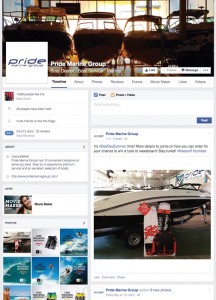 One great way to drive engagement is to run a Facebook contest and give away prize packs, which is a regular practice for Pride Marine Group.
One great way to drive engagement is to run a Facebook contest and give away prize packs, which is a regular practice for Pride Marine Group.
However Bailey said it is important to outline specific rules in a social media contest, particularly because you have to justify choosing a winner. If you provide exact rules that are easy for the customers to understand, you can automatically eliminate anyone who doesn’t follow those rules properly.
“It’s not something where you can throw up a post and say ‘We’re going to give away this, this is the contest,'” said Bailey. “If it’s loose and there’s not direct guidelines, it’s very difficult to get people to participate and the people that do participate will complain if they don’t win.”
5 STEPS TOWARD A THRIVING PAY PER CLICK CAMPAIGN
![]() There are several ways to get to work on pay per click marketing. Facebook and Twitter are popular vehicles and Bing has a robust system, but the majority of people will be using Google Adwords as their first platform. For uninitiated businesses, here are five steps toward creating a well-optimized campaign for the first time. Seasoned pay per click advertisers can head to the Boating Industry website for some expert tips.
There are several ways to get to work on pay per click marketing. Facebook and Twitter are popular vehicles and Bing has a robust system, but the majority of people will be using Google Adwords as their first platform. For uninitiated businesses, here are five steps toward creating a well-optimized campaign for the first time. Seasoned pay per click advertisers can head to the Boating Industry website for some expert tips.
Step one: Establish Goals
Even before creating an AdWords account, you have to set some clear goals for your pay per click campaign. Goals like, “buy a boat” are far too broad and difficult to measure. Some good goals are collect email signups, get calls (via a unique phone number or added tracking), click a button (useful for seeing how many customers are checking hours before they come in), view a video and grow boat information requests. Each of these goals will be a conversion for you to track your campaign at a granular level.
If a business doesn’t have goals to begin with, it’s going to be wasting a lot of money figuring out what exactly it wants customers to do. So it’s wise to do the work up front.
Step two: Set a budget
Setting a budget early will keep a business in line. It’s frighteningly easy to rack up a huge bill with poorly optimized campaigns, so a simple budget will keep ad dollars in line, even if something goes awry. Create a line item within the marketing budget and set a daily budget within the AdWords system that matches. Then be sure to set an end date or make a reminder to check in on the ads toward the end of the campaign.
Step three: Research keywords
Finding the right keywords is a central issue for PPC advertising. It’s something that must be continually updated as a business advertises in a shifting commerce landscape. But, for the first campaign let Google do the work. By using Google’s keyword tool (adwords.google.com/KeywordPlanner), a business can get on the right track without poring over their analytics.
Simply drop in your website and choose your product category, which will be nested under “Vehicles” for the majority of stakeholders in the boating industry. The PPC operator can pick and choose the keywords that have a good volume of search traffic and fit within the bid range the
business sets.
Keywords have a sweet spot for conversion – specific enough to get a click but broad enough to show up in searches. For example, if a business has a 1983 Lund DLX-20 for sale, they shouldn’t put the model number in the keyword – not many people are searching for this specific boat from 1983. But going after “Lund Boats,” “aluminum fishing boat,” etc., will get searchers who might not know that their next boat will be the DLX-20. Getting too broad is just as bad as being too specific. Don’t try to bid for all boating-related keywords out there, otherwise ads will be popping up for any search for fishing or Ryan Gosling’s new romantic comedy with a boat scene.
The majority of boat-related businesses operate within a set local area, so advertisers must also be sure to target keywords that are being used in their area or run the risk of wasting ad dollars on someone across the country.
Step four: Create your ads
The biggest rule for a business to be aware of when creating an ad is the rule against trademarked copy. Just steer clear of using any trademarked term in PPC ads. Only a trademark holder can use a trademark. You can, however, put trademarked terms in your keywords. So, if a business is selling used Lund Boats, an ad might read “Used Aluminum Fishing Boats” and rank for “Lund Fishing Boats” as a keyword.
Aside from that, getting together with the marketing staff and setting guidelines about what to say is a great way to start. Due to the small amount of space for ad copy (25 character headline and 70 characters of descriptive text) it often takes some finagling to get something that reads well.
It’s wise to set up several campaigns to target different keywords. What might resonate for customers searching for fishing boats likely won’t click for a sailor looking for a new catamaran. But no matter how well the ads perform, having several campaigns running will deliver a ton of useful data for the next step.
Step five: Test, tweak and purge
The ad and the keywords … well, that was the easy part! Now the real work of running PPC advertising comes into play, and it’s all about testing. After a few weeks of campaigns – even a few days in larger search markets – campaign statistics tell a whole lot about ads, customers and how they search for their new boat.
The first thing to look at is Quality Score. It determines how useful an ad is in Google’s eyes. Depending on the landing page, how the campaign is set up and keyword relevance, Quality Score determines where an ad is placed and how much each bid costs. A very low Quality Score means there is something wrong with an ad: It’s either just not clicking with searchers or the keywords aren’t in line with the landing page. An issue here is remedied in one of two ways fixing it or shutting it down. For an aberrantly low score, it’s best to just shut it down and focus on better performing ads. But if no ads in a campaign have a high Quality Score something needs to be fixed. Either the keywords are too specific or too broad or there is an issue with the landing page not having enough on-topic content. Try always to link directly to a page that has a lot of regularly updated content, model listings or a targeted landing page work the best.
“Wasted spend” is another metric that will help drive up a business’s PPC ROI. All those impressions with no clicks mean wasted money. This step in the process is where advertisers should start honing their keywords to both trim the fat and look for more meat. If “fishing boats” is converting well, adding keywords for “used boats,” “cheap boats,” “new fishing boats,” etc., can expand that specific campaign’s keywords without getting too broad.
Creating a test in the AdWords system is a great way to diagnose what the issue is or squeeze more clicks from a high-performing campaign. This is in the advanced options but should be a standard practice. By experimenting, advertisers can enhance their ads in a data-driven environment instead of going with their gut. Keeping an ad as a control, an advertiser can test new keywords, bidding strategies and other advanced features like targeted timing and easily apply their findings to the rest of the campaign.
After you’ve had a few PPC campaigns running and tweaked them to your satisfaction, it’s time to get even more out of your ads with these advanced tips:
Remarketing
You know how after you look at a toaster on Amazon and a week later, you’re still seeing toasters on every website you visit? That Tell-Tale Toaster isn’t haunting you, it’s just remarketing.
This tool will help your ads follow your prospective customer wherever they go. Any site that offers AdSense (which is the majority of popular sites around the Web including email) has the ability to serve up your ads.
Setting these up is a little more technical and will require that a business tag their site to build up valuable data about visitors. But anyone familiar with PPC and Google Analytics will be able to create a complete remarketing strategy with a little time.
Google has a step-by-step guide to remarketing that covers everything necessary to get started. Then — like a typical PPC campaign — it’s all about testing and tweaking.
Get a phone call
Even the best conversion rates don’t come close to the historic conversion rates of a simple phone call. So get people on the phone as soon as possible with AdWords Extensions.
There are several ad extensions ranging from app downloads to reviews and addresses. For the boating industry and it’s mature demographic, however, the ability to cut past everything and just talk to someone is incredibly valuable.
Most of these extensions including the phone call tool are free to set up, and only incur a nominal extra fee if they are used.
Once someone is on the phone, your customer service, personality and all the other powerful soft skills take over.
Target mobile differently
The mobile version of your website displays different from your desktop website (or should), so why are your ads the same?
People browsing on smaller screens are often looking for different things. A desktop user might be browsing for beautiful boat photos, but a mobile browser might just be looking for a nearby marina. Even with the same search terms, each user is likely looking for something very different.
Intents are different, and display is too. That tiny amount of ad copy in a PPC ad gets even smaller to make room for site extensions. Keywords should be changed too, targeting terms like “near me” and the business zip code can drum up a lot more mobile search results.
So shrink your call to action, tweak your terms and emphasize what users are looking for. Mobile is the perfect place to put a phone call extension. Your customer can seamlessly go from browsing to calling with a click or two.
5 WAYS TO EFFECTIVELY USE INSTAGRAM
![]() 1. Be human
1. Be human
Instagram is less of a selling venue and more of a medium for companies to show the personality of their businesses.
“It’s an experience. It’s not necessarily the boat itself that [you’re] selling: It’s the memories, the experience, the fun, the thrill, the excitement,” said Scott. “That’s what you’re selling. So making sure that those images really express that.”
Instagram is, by and large, a younger audience. Whatever content you post should be attracting this audience and introducing them to the boating lifestyle.
2. Use your hashtags
Instagram makes it easy to search hashtags and see what is popular among other users. Be sure that whatever hashtags you are using are directing customers to your content. Scott says Iconosquare is a great tool for searching popular hashtags and providing statistics to see what is or isn’t working on your Instagram account.
3. Diversify your content
![]() Instagram allows you to post photos and 15-second videos, so make sure you post a healthy dose of both.
Instagram allows you to post photos and 15-second videos, so make sure you post a healthy dose of both.
Blackwell suggested dealers could use Instagram to post “boating hack” videos that feature do-it-yourself boating tricks. For instance, service employees could make a fast video of a DIY repair trick when a customer is out on the water and needs a quick fix.
4. Repost interesting content
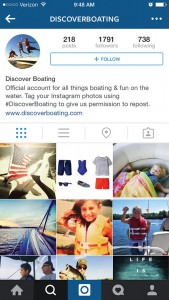 Apps such as Repost and Regram allow users to post content from other Instagram accounts to their own with attribution to the content source. Dealers and manufacturers can follow organizations such as Discover Boating and repost any content they think would be interesting to their customers.
Apps such as Repost and Regram allow users to post content from other Instagram accounts to their own with attribution to the content source. Dealers and manufacturers can follow organizations such as Discover Boating and repost any content they think would be interesting to their customers.
5. Provide a call to action
As with all digital marketing, the only way to know if it’s worth your time is to measure your engagement. Ultimately, you want them to visit the website, call the store or otherwise interact with your brand.
If you are posting links on Instagram, or any other social network, Scott suggests using a link shortener such and Bitly, Owly, HootSuite or TinyURL with a short link on each specific platform to identify analytics on who is clicking what.
ONE GOOD REASON TO STAY ON GOOGLE+
![]() There has been a lot of buzz lately that Google’s decision to phase out Google+ as it is today to make way for Google Streams and Google Photos is “the death of Google+.” However, the Google+ experience will still exist in terms of sharing content and photos. What does this mean for businesses? Should they still be spending time on Google+? Scott says absolutely, and here’s why: It is fantastic for a company’s search engine optimization.
There has been a lot of buzz lately that Google’s decision to phase out Google+ as it is today to make way for Google Streams and Google Photos is “the death of Google+.” However, the Google+ experience will still exist in terms of sharing content and photos. What does this mean for businesses? Should they still be spending time on Google+? Scott says absolutely, and here’s why: It is fantastic for a company’s search engine optimization.
 “Google is the largest search engine in the world so it still would make sense to leverage that as it relates to SEO. That’s how we use it for most of our clients,” said Scott. “For instance, if you have a specific set of key words that you’re really working on, use your social media posts on Google+ to support that effort.”
“Google is the largest search engine in the world so it still would make sense to leverage that as it relates to SEO. That’s how we use it for most of our clients,” said Scott. “For instance, if you have a specific set of key words that you’re really working on, use your social media posts on Google+ to support that effort.”
4 REASONS TO USE EMAIL MARKETING
![]() To some email marketing may seem outdated, but it remains an effective tool for a company – when used correctly. Here are the reasons you should use email campaigns in your marketing strategy.
To some email marketing may seem outdated, but it remains an effective tool for a company – when used correctly. Here are the reasons you should use email campaigns in your marketing strategy.
1. When not overused, email marketing can be very successful
Boertje said email marketing has a unique usage from social media and other digital marketing platforms and should be treated as such in order to be successful.
“We send emails out when there is something truly actionable and of value to the customer. We don’t just sit and blast emails out because then you train people to stop opening it. We all know those emails we hate to get or we can’t wait [to] unsubscribe from,” he said.
2. Email marketing is 1:1 communication
If a company is set up correctly in terms of data capture and data management and targets its emails directly to a consumer’s wants and needs, email marketing can be powerful.
“It’s the quickest and easiest non-intrusive way and fastest way to communicate one-on-one,” said Scott.
Companies can customize email marketing to be personal, which appeals to customers’ desires to feel relevant and important. Scott said marine businesses should look into channels such as Mad Mimi, Mail Chop, Constant Contact or any CMS system that will help with email marketing.
However, if you are going to use these sites, it is important to be sure your contact list is validated and has been recently cleaned, or it could lead to hefty consequences.
“If you try importing a list like that into Constant Contact, for example, and you send it out and you get a 50 percent bounce rate or spam complaints, you can easily get blacklisted, in which case they close your account, keep your list and give you nothing, and you can never use them again,” said Scott.
Scott uses datavalidation.com, which gives you a report on which email addresses are good, bad, old, closed or spam for the price of less than a penny per email address.
3. Data collection creates prospective clients
It’s important for dealers to be collecting data from its customers to be sure they are targeting their email marketing accurately. Creating a database of customers’ names, email addresses and other identifiable information, such as what make and model of boat they last purchased, is extremely useful for knowing the right times to email customers.
“If they have a used [boat] come in and it’s a 53-footer, and they want to send that to people who might be interested, you’re not going to send that to the person who bought the 17-foot Bayliner because they’re obviously not in that market,” said Scott. “You want to make sure that you’re really sending [email communication] to people who would be interested in it.”
4. Marketing that is measurable
Email marketing is easy to track and measure what is or isn’t being engaged with, from opens to clicks to forwards.
“If you’ve got any kind of hot spot measurement tools going on, you can see where are people hovering, where are they spending time, what are they looking at,” said Scott.
6 TIPS FOR GETTING THE MOST OUT OF YOUR COMPANY BLOG
![]() Company blogs keep you in contact with your customers and establish your brand voice. However, they won’t do you any good if you aren’t posting content. Here are some tips for keeping the creative juices flowing.
Company blogs keep you in contact with your customers and establish your brand voice. However, they won’t do you any good if you aren’t posting content. Here are some tips for keeping the creative juices flowing.
1. Ask your customers and employees
Scott said PTE asks its clients to ask their customer base what content they want to read. She recommends sending a two or three question survey to customers through a free service like SurveyMonkey or a paper survey that salespeople can give customers in the store.
“It’s incredibly powerful because what you don’t want to do is set something up, whether it’s a blog or otherwise, and be putting content up and not getting any engagement, and you have no idea why when you could just ask that question,” said Scott.
At Texas Marine, Donna Chance is the writer and updates the blog by coming up with original content ideas, as well as through discussions with department managers at the dealership. A parts manager may give her an idea for a blog post on safety equipment and a service manager may offer a blog post on new seasonal maintenance tips.
2. Make it a part of your website
Scott says dealers should be using a website platform that allows for a company blog to be integrated into the website.
“[Using a different website] really isn’t providing the value that it could if it was part of their site, because they’re directing traffic somewhere else,” Scott said.
3. Set a schedule
Ryan Hebert, administrator at Texas Marine, said the dealership posts on its blog daily, striving to meet a minimum of three time a week.
“We find this keeps the momentum going as we post the blog on other sites and gain followers. Some of the posts will be simply three short interesting paragraphs and others much longer,” said Hebert.
4. Assign someone to do the writing
 Hebert said that Texas Marine realized if the dealership was going to get serious about building an online presence, dollars would have to be set aside and dedicated for this purpose. The team determined a full- or part-time writer would be necessary and hired Chance.
Hebert said that Texas Marine realized if the dealership was going to get serious about building an online presence, dollars would have to be set aside and dedicated for this purpose. The team determined a full- or part-time writer would be necessary and hired Chance.
5. Research topics from other sites
If ideas are hard to come by, dealers should consider looking at other sources, not to steal posts but to get inspired. Hebert says sites like takemefishing.org spark ideas and help keep content flowing.
Scott suggests looking at the yearly calendar and writing posts that have a theme based on the current month. For example, if it is July, Independence Day is a major holiday and you could dedicate your blog posts that month to highlighting American-made boats or engines. She also recommended keeping an eye out for times of the year when there is a significant amount of industry news, such as new product releases or awards ceremonies.
6. Track your engagement
Texas Marine uses Facebook and Google analytics to determine which blog posts are being engaged with the most often. If a post appears to be particularly popular, it may be a subject worth revisiting in a future post.
“We stick to the subjects that are getting the most play from the analytics,” said Hebert.
6 TIPS TO SLIM YOUR WEBSITE FOR THE SMALL SCREEN
![]() Back in April, Google made some big changes to how it serves mobile searches.
Back in April, Google made some big changes to how it serves mobile searches.
The change garnered the frightening name “Mobilegeddon.” While the effects haven’t been nearly as catastrophic as feared, the change reminds businesses that they need to focus on their mobile presence as customers shift to mobile devices.
Here are six tips that can help any business hone their mobile presence.
1. Know your audience
Before doing anything, a business should dig into their web analytics right away to see how customers are interacting with the website. Via analytics, a business can see where to focus its efforts. If users are mostly using phones and not tablets, mobile efforts should be focused on the smaller screen. Seeing what kind of information mobile users are seeking will also help prioritize the most valued content.
2. Test your site
Google provides a comprehensive test to really demonstrate where the issues are as far as mobile. Just search “Google mobile test.” The tool shows how your site looks on mobile and gives deeper insights into what might be slowing things down.
3. Be responsive
 Every site needs to be responsive — either the entire site or a mobile version of the site (fully responsive is always better). This might mean a new platform for the business or just some new code. If a business’s site doesn’t align with the edges of a mobile device, it’s time to set up a meeting with the service provider or the in-house developer. Many sites will only need an updated style sheet that includes “at media tags.” These tags guide how a site looks in a mobile setting.
Every site needs to be responsive — either the entire site or a mobile version of the site (fully responsive is always better). This might mean a new platform for the business or just some new code. If a business’s site doesn’t align with the edges of a mobile device, it’s time to set up a meeting with the service provider or the in-house developer. Many sites will only need an updated style sheet that includes “at media tags.” These tags guide how a site looks in a mobile setting.
4. Make content mobile-friendly
Mobile web users want their information fast. That means concise descriptions, easy-to-navigate slideshows and video. Think with your thumb for this step: everything on the site should be easy to reach and interact with while holding a phone. The easiest way to do this is by just browsing within the business. Task a few people with doing a mock purchase to make sure everything flows well.
5. Get your contact info up front
Don’t hide critical contact information behind a menu or at the very bottom of a page. A huge number of mobile users just want to find a phone number or address – make it easy for them. Hours of operation, a map link and a link to a contact form should be front and center.
6. Show up in local search
Successful sales and service businesses already have good local search visibility, but it’s even more important for mobile search. Even diehard customers will probably search in broad terms to find their favorite business. If the business isn’t showing up, they’re going to be mapping a route to someone else.

